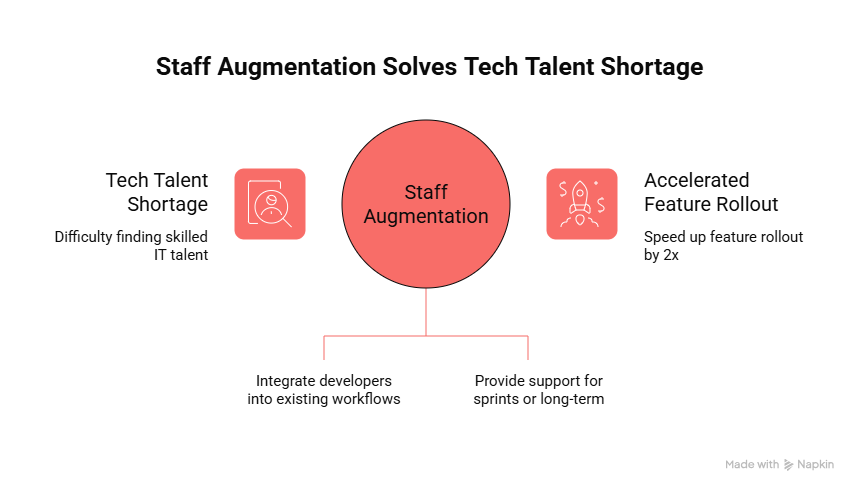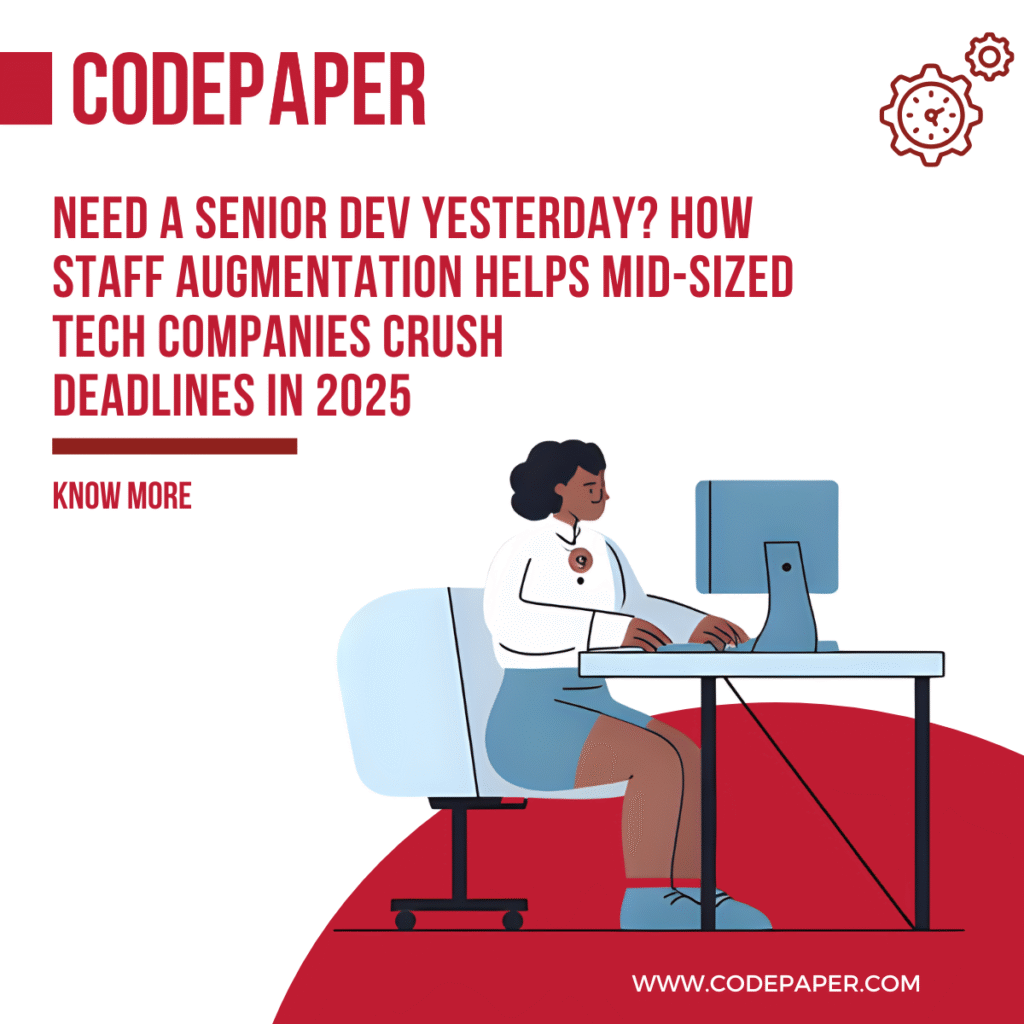Introduction: The Talent Crunch Hitting Mid-Sized Tech Companies Hard
“Need a senior dev yesterday? Augment your team and crush deadlines—real case study inside!” If you’re a CTO or project manager at a mid-sized tech firm with 50-200 employees in software, SaaS, or web development, this hook probably resonates. In 2025, the tech industry is booming, but so is the talent shortage. In Canada, the tech sector is projected to grow by 1.4% to 1.46 million workers, yet 70% of businesses cite a shortage of skilled IT talent as a major barrier. Globally, 76% of IT employers struggle to find the right talent, leading to delayed projects and lost opportunities.
For mid-sized companies, this means slower development cycles that hinder competitiveness, challenges in finding senior developers for SaaS teams, and an increased risk of burnout among your current staff. Burnout rates in tech are alarmingly high, with 38-83% of workers affected, especially in hardware and infra roles. The result? Teams pushed to their limits, innovation stifled, and revenue growth stalled.
Enter staff augmentation for mid-sized tech companies—a flexible model to add senior developers or specialists (like DevOps engineers) for sprints or long-term support, integrated seamlessly into your workflows. This guide will explore the benefits, debunk myths, share real case studies, and provide a step-by-step implementation plan. By the end, you’ll see how augmentation can speed up your SaaS feature rollout by 2x while keeping your team energized. As discussed in our recent X thread on the mega-framework for tech scaling, and our LinkedIn post with key lessons, these strategies are practical and proven. Let’s dive in and turn your pain points into competitive advantages.

What Is Staff Augmentation and Why It’s Perfect for Mid-Sized Tech Firms
Staff augmentation is an outsourcing strategy where you hire external professionals to supplement your in-house team temporarily, filling specific skill gaps without the commitments of full-time employment. These experts—such as senior developers or DevOps specialists—work as part of your team, using your tools (e.g., Jira, Slack, GitHub) and following your processes.
For mid-sized tech companies, this model is ideal because you’re at a stage where you need specialized talent to scale but can’t afford the time or cost of traditional hiring. Full-time recruitment can take 3-6 months and cost $120k+ per role, including salaries, benefits, and fees. Augmentation offers rates of $80-150 per hour, with onboarding in as little as 48 hours. In Canada, where the tech talent shortage is acute (with unemployment at 3.3% but demand surging), augmentation provides access to a broader pool while maintaining timezone alignment.
The key difference from outsourcing is control: You direct the augmented staff, ensuring alignment with your company culture and goals. This flexibility is crucial for SaaS teams needing to iterate quickly or web dev firms handling variable client loads. As per 2025 trends, companies using augmentation report 40% reduction in turnover and 20% improvement in employee satisfaction. It’s not just about filling seats—it’s about empowering your team to innovate without overload. For more on the framework, check our X thread.
Addressing Key Pain Points: Practical Solutions with Staff Augmentation
Mid-sized tech firms often face a trifecta of challenges: speed, talent acquisition, and team sustainability. Staff augmentation tackles each head-on with targeted strategies.
Accelerating Development Cycles to Maintain Competitive Edge
In SaaS and software, speed is everything. Delays in feature rollouts can mean lost market share. How to accelerate development cycles with augmentation? By injecting specialists for bottleneck areas, like a senior frontend dev to optimize user interfaces or a backend expert for database scaling.
For instance, if your team is bogged down by a complex API integration, augmenting a specialist can cut the timeline from months to weeks. A tip: Conduct a cycle audit—map your process and identify slowdowns (e.g., “Bottleneck in code reviews”). Augment for 2-4 weeks to resolve them. Companies implementing this see up to 2x faster rollouts, as per industry guides.
In practice, a Toronto SaaS firm augmented for a feature update, cutting cycle time by 50% and boosting user acquisition. This agility is vital in 2025, where AI and cloud trends demand rapid adaptation. Our LinkedIn post shares quick lessons on this.
Overcoming the Challenge of Finding Senior-Level Talent Locally
Local talent pools in Canada are competitive, with 88% of tech leaders reporting hiring struggles. Roles like senior DevOps or AI specialists are especially hard to fill, leading to project stalls.
Augmentation solves this by connecting you to a pre-vetted network of experts. Finding senior developers for SaaS teams becomes straightforward—providers match based on your tech stack (e.g., AWS, Kubernetes). Tip: Specify requirements clearly (e.g., “Senior with 10+ years in Kubernetes”). This perfects the fit. This reduces hiring time from months to days.
A web dev company augmented a cybersecurity expert amid local shortages, passing audits and securing contracts. The benefit? Immediate impact without relocation costs.
Preventing Burnout Among Your Current Staff for Long-Term Success
Burnout is a crisis in tech, with rates at 38-83% and 66% of employees affected overall. For mid-sized firms, overworked teams lead to 23% turnover.
Preventing burnout in tech teams with augmentation distributes workloads during peaks. Augment for 2-4 months to handle surges, allowing your staff rest. Tip: Use surveys to monitor—augment when overtime hits 20%. A software team did this, reducing burnout from 60% to 10% and boosting productivity.
Additional Strategies:
- Knowledge Transfer: Augmented experts train your team, building internal capabilities.
- Hybrid Models: Combine with internal rotations for balance.
Ensuring Seamless Integration and Knowledge Transfer
One concern is disruption, but modern augmentation emphasizes integration. Pros join your tools and participate in stand-ups.
Tip: Start with a 1-week trial period for alignment. This builds trust and enables knowledge transfer, where augmented experts train your team—turning temporary help into long-term gains.
Example: A mid-sized app dev firm augmented for frontend—using GitHub flows, they hit deadlines without hiccups.
Cost Savings and Flexibility in a Volatile Market
Hiring full-time adds fixed costs; augmentation is variable. Save 50% on overheads while scaling. For mid-sized firms, this means better cash flow for R&D.
Tip: Use ROI calculators—factor time saved vs. hourly rates. This approach allows companies to ramp up or down quickly based on project needs.
Building Innovation and Long-Term Resilience
Augmentation brings fresh perspectives, fostering innovation. Access to specialists helps you stay ahead.
Tip: Augment for “innovation sprints”—dedicated time for new features. This keeps your company resilient in 2025’s dynamic landscape.
| Challenge | Traditional Hiring | Staff Augmentation |
| Time to Onboard | 3-6 months | 48 hours |
| Cost | $120k+ annual | $80-150/hr |
| Flexibility | Fixed contract | Scale up/down |
| Risk of Burnout | High (overloads team) | Low (shares load) |
| Innovation Boost | Slow | Immediate expertise |
Real-World Case Studies: Proven Success in Tech
Case studies demonstrate augmentation’s impact.
- Case Study 1: SaaS Firm in Toronto (Cycle Acceleration) A 120-employee SaaS company needed AI integration but lacked seniors. Augmented 2 specialists for a 3-month sprint. Integrated via Jira, they sped cycles by 2x, adding 25% users. Cost: $50k vs. $250k for hires.
- Case Study 2: Web Dev Company in Vancouver (Talent Gap) Facing local shortages for frontend, they augmented a full-stack senior. Onboarded in 48 hours, delivered 30% faster projects. Knowledge transfer reduced future needs.
- Case Study 3: Software Startup in Calgary (Burnout Prevention) 90 employees during a pivot—augmented 4 devs for 4 months. Workload shared, burnout dropped 50%, revenue up $400k.
- Case Study 4: Pumex Computing (Operational Efficiency) Augmented for QA/testing—resolved capacity issues quickly, improving efficiency by 35%.
- Case Study 5: Talmatic Client (Team Extension) Augmented for custom software—enhanced efficiency and met deadlines.
- Case Study 6: Inteleos IT (Staffing Scale) Doubled IT department with PMs/analysts—quick onboarding for projects.
- Case Study 7: ParallelStaff (Nearshore Talent) Augmented for tech growth—real results in scaling.
These illustrate ROI: faster delivery, cost savings, happier teams.
Step-by-Step Guide to Implementing Staff Augmentation
Follow this to get started.
- Assess Needs: Audit projects—identify gaps (skills/workload). Use tools like surveys.
- Define Requirements: Specify stack/experience. Tip: Create a job brief.
- Select Provider: Choose based on vetting—Codepaper for tech focus.
- Onboard: Share access, hold kickoffs. Buddy system for integration.
- Set KPIs: Track velocity/burnout. Adjust weekly.
- Monitor & Communicate: Daily stand-ups, feedback loops.
- Offboard: Knowledge sessions for retention.
- Evaluate & Iterate: Post-project review—scale future use.
Challenges: Cultural fit—solve with trials. Cost—use budgets.
For a framework, see our X thread.
Debunking Common Myths About Staff Augmentation in Tech
Myths persist—let’s bust them with facts.
- Myth 1: Expensive Than Hiring. Reality: Saves 50%—pay per hour, no benefits.
- Myth 2: No Control. You direct the team—full integration.
- Myth 3: Low Quality. Vetted seniors often exceed locals.
- Myth 4: Cultural Mismatch. Proper management ensures fit.
- Myth 5: Only Short-Term. Works for long-term too.
- Myth 6: Communication Issues. Timezone alignment minimizes.
These debunkings help overcome hesitation. See our LinkedIn post for quick tips.
Conclusion: Empower Your Mid-Sized Tech Team Now
In 2025, mid-sized tech companies must adapt or fall behind. Staff augmentation for mid-sized tech companies addresses core pains—accelerating cycles, sourcing seniors, preventing burnout. With case studies showing 2x speed and 50% savings, it’s a proven path.
Act today: Audit your team. What’s your biggest hurdle? Comment below! For tailored support, contact Codepaper.
FAQs
- What is staff augmentation for mid-sized tech companies? Adding experts to your team on-demand for flexibility.
- How to accelerate development cycles with augmentation? Augment specialists for sprints—cut times by 2x.
- How to find senior developers for SaaS teams? Use providers for 48-hour matches.
- How to prevent burnout in tech teams with augmentation? Share loads during peaks—reduce overtime 20-40%.
- Is it cost-effective? Yes, save 50% vs. full hires.
- How long to onboard? 48 hours typically.
- Can it be long-term? Yes, flexible extensions.
- What’s the ROI? 2x productivity, 25% revenue growth.
- Any risks? Minimal with vetted providers.
- Best for which tech areas? SaaS, software, web dev—adaptable.
